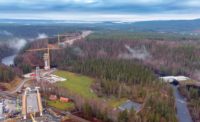While the saga of the tunnel-boring machine dubbed “Bertha” has dominated headlines (see p. 9), another controversial but crucial project is progressing right next to the Alaskan Way Viaduct replacement work. In the first phase of the Elliott Bay Seawall Project, crews are building jet-grout columns and precast structural elements along the Seattle waterfront to replace 20,000 old timber piles eaten by gribbles.
“The seawall holds up a section of our waterfront,” says Lorelei Williams, capital projects manager for the city of Seattle. “We started construction at the end of 2013, with utility relocations and moving the roadway. In early 2014, we started on the physical wall.”
A joint venture of M.A. Mortenson Co. and Manson Construction Co. holds the construction manager-general contractor contract for the first phase of the project that replaces 3,720 ft of the 7,000-ft-long old wall, built between 1916 and 1934. The seismic vulnerability of the old wall, a concrete facade supported by landfill and timber piles, prompted voters to approve a $290-million bond measure in 2012.
“The concept is a soil improvement project that consists of jet-grout columns from 4 feet to 6 feet in diameter and as tall or deep as 80 feet,” says Sam Owen, Mortenson Construction executive. “We have 6,000 columns along the waterfront—they stabilize the soil. We have 4- to 5-feet-deep foundation slabs on top. From there, we build the seawall with panels and precast segments to hold up the sidewalk.”
Crews installed sheet walls as deep as 60 ft into a compressed sand layer to hold back the water, Owen says. “There is a lot of groundwater. The original concept was to drill wells and dewater. Then, we decided to do a soil freeze. Every 3 to 5 feet, we created a barrier between the city and jobsite. We built a wall of ice up to 40 feet deep and 3 to 5 feet thick. Defreezing takes about four weeks or so. We can turn off the brine and let it thaw slowly, or we have the option to put hot water through it.”
Crews installed almost 400 Z-panels—that is, precast, cantilevered beams. “We built the slab, set the face panels, set the Z-panels, then filled in behind them,” says Owen. Adds Williams, “These are textured panels that create habitat opportunities for ecosystems.” Also serving that purpose are 440 rock-filled mesh bags, called “rock pillows,” that rest on the seabed and a cantilevered sidewalk jutting from the new wall. The sidewalk will feature glass blocks because young salmon cannot swim in darkness, says Williams. The light also will promote plant growth.
Rocky Conditions
The team has encountered unknowns in the complicated job, such as old street cobbles and structures. “In February, they were installing sheets at the north end and found big pieces of concrete material. They had to drill holes into them to break them up,” says Williams.
Due to such unpredictable conditions, the cost estimate has risen to $410.2 million from $339.2 million. Mortenson officials attribute the increase to the dewatering strategy and soil freeze.
In April, subcontractor Hayward Baker Inc. filed a lawsuit in King County Superior Court, claiming the joint venture owed it $7.1 million for changes due to unexpected containment-wall movement during its jet-grouting subcontract. Last January, Hayward Baker “observed unstable ground conditions … some of its drill rigs tilting and a berm that had been erected appeared to be sinking,” according to the lawsuit.
The suit alleges micromanagement, such as demands for stop-and-start work, modified sequencing and use of pedestrian bridges over the work space, rather than providing 75 ft of space for each drill rig.
“All involved parties acknowledge the need to follow the dispute resolution process as outlined in the contract,” said Mortensen in a statement. “This does not affect the timeline of the project.” Completion is slated for late this year.






Post a comment to this article
Report Abusive Comment